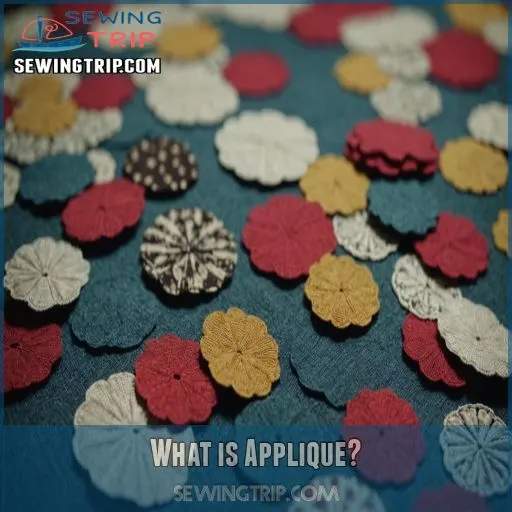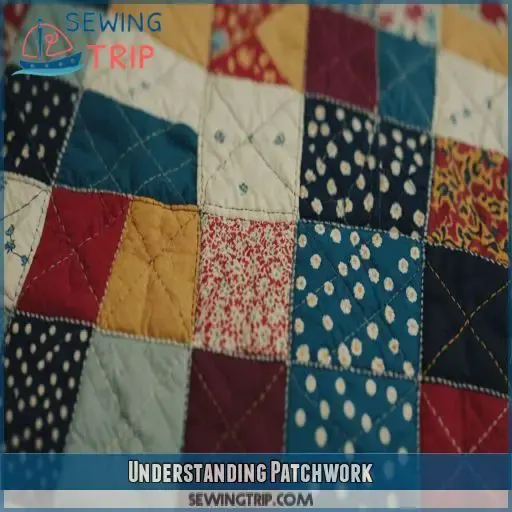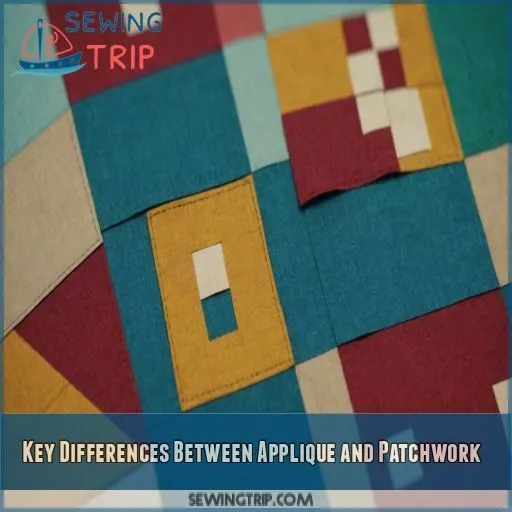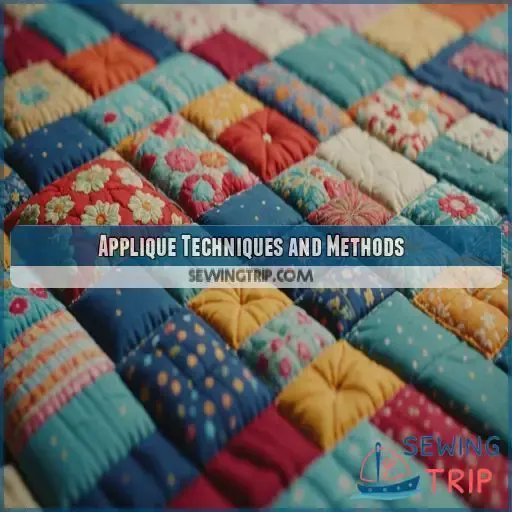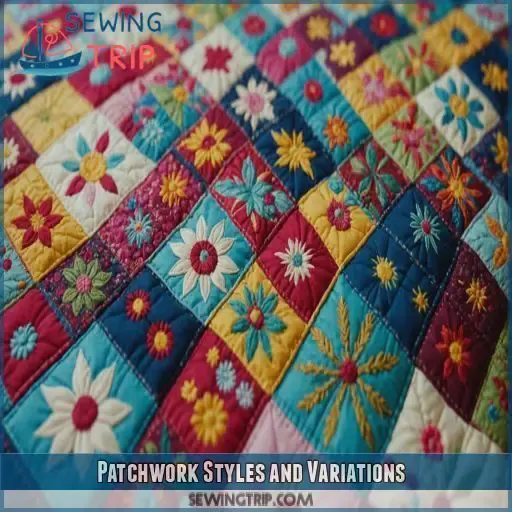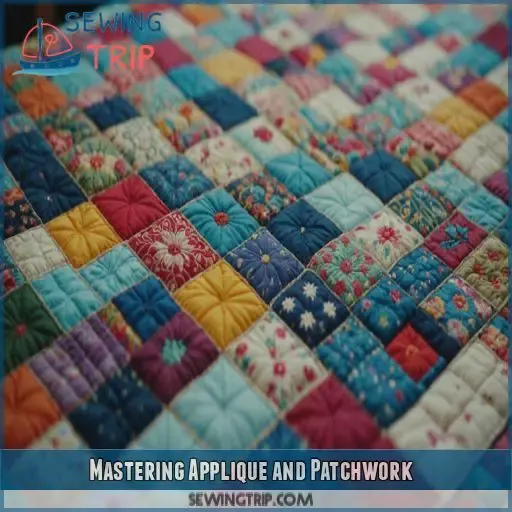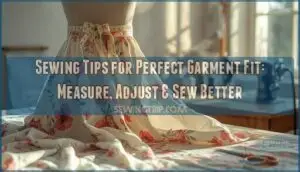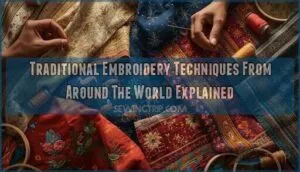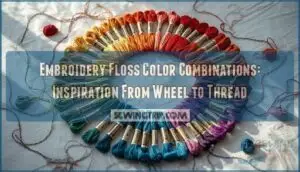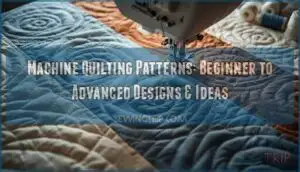This site is supported by our readers. We may earn a commission, at no cost to you, if you purchase through links.
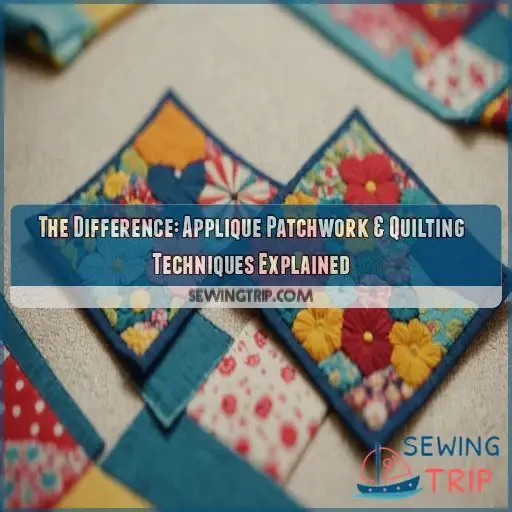 Patchwork and appliqué might look similar, but they’re actually very different.
Patchwork and appliqué might look similar, but they’re actually very different.
The main difference is the background fabric.
Patchwork connects small fabric pieces without a background, while appliqué involves sewing pieces onto a larger fabric.
Patchwork is more functional, while appliqué is decorative, layering fabrics to create images.
Table Of Contents
Key Takeaways
- You’re dealing with two distinct fabric techniques: appliqué layers pieces onto a background (think adding sprinkles to a cupcake), while patchwork joins pieces edge-to-edge (like solving a fabric jigsaw puzzle). This fundamental difference affects how you approach your projects and the final look you’ll achieve.
- Your creative freedom soars with both methods, but in different ways. With appliqué, you can create intricate designs and curves that would make a roller coaster jealous. Patchwork, on the other hand, lets you play with geometric patterns that could give m.c. escher a run for his money.
- You’ll find that appliqué and patchwork have different learning curves. Appliqué might test your patience as you master techniques like needle-turn (it’s like trying to fold an origami crane with fabric), while patchwork challenges your precision in cutting and piecing (measure twice, cut once, or you’ll be in a sticky situation).
- You can actually combine these techniques for projects that are more layered than your grandma’s famous lasagna. Mixing appliqué and patchwork opens up a world of creative possibilities, allowing you to add depth, texture, and visual interest that’ll make your quilts the talk of the town (or at least your sewing circle).
What is Applique?
Applique is a delightful fabric art where you can express your creativity by applying pieces of fabric onto a larger surface to form designs, almost like creating a patchwork painting with fabric! It’s not just about adding shapes; it lets you play with texture and color, giving your quilts a unique flair that can transform them from ordinary to extraordinary.
Definition and Origin of Applique
Appliqué, with a history as rich as a tapestry, is where fabric pieces are artfully laid onto a larger canvas, creating delightful designs.
It’s like giving fabric the freedom to dance on a larger stage!
Originating from the French word for "applied," this technique allows creators to fuse imagination with materials using styles like satin stitch and tools like fusible thread.
Benefits of Applique in Quilting
Let’s explore the joys of applique in quilting! Embrace the liberty to create stunning curves with ease. Applique adds texture and detail that make your designs pop. Plus, your stitches can remain invisible with matching thread. Here are benefits that will hook you:
- Unique embellishments
- Easy curve creation
- Hidden stitching
- Design versatility
Types of Applique Techniques
Applique offers a world of creative possibilities! Whether you prefer needle-turn, freezer paper, or fusible applique, each technique has its own unique charm. Experiment with blanket stitches, buttonhole stitches, or even ladder stitching to add depth and texture. Don’t be afraid to get a little water-soluble thread involved – it’s a game-changer!
Understanding Patchwork
When you think of patchwork, imagine a vibrant quilt stitched together piece by piece, much like life itself. This technique, with its humble origins in ancient Egypt, evolved through history, shaping diverse modern applications today.
History of Patchwork
Patchwork has a rich tapestry of history, weaving through time like a colorful quilt itself. Originating from ancient Egypt, patchwork evolved out of necessity and creativity, stitching together fabric scraps. Over centuries, it became an art form, influenced by diverse cultures. From soldiers’ quilted armors to intricate designs, patchwork reflects humanity’s ingenuity in textile innovation and cultural expression throughout history.
Traditional Patchwork Techniques
Start with a patchwork quilt design that’s simple yet profound. Start by focusing on:
- Geometric patterns for structure
- Careful fabric selection to make sure the colors and textures work well together
- Precise hand stitching for durability
- Incorporating seam allowance to avoid chaos
- Using freezer paper for templates
Each piece tells its own story, while together they create a quilted symphony!
Modern Patchwork Applications
In today’s modern world, patchwork has transcended its humble quilting roots, finding its way into fashion, art, and home decor.
From bold, geometric designs adorning clothing to intricate patchwork canvases that blur the line between craft and fine art, the possibilities are endless.
Explore your creativity by upcycling fabrics into one-of-a-kind patchwork projects that add a touch of personality to any space.
Key Differences Between Applique and Patchwork
When you’re quilting, distinguishing between applique and patchwork can be as tricky as untangling a skein of yarn, but it’s worth it. Understanding these techniques—all about attaching fabric, creating designs, and adding texture—will help you create more dynamic and imaginative pieces.
Fabric Attachment Methods
Patchwork pieces fit together like a jigsaw puzzle, but applique fabrics sit on top, each with its own charm. When attaching pieces, you might:
- Hand-stitch for a rustic touch.
- Machine-stitch for speed and precision.
- Use fusible web or glue for quirky ease.
- Secure with safety pins, but don’t get too attached!
Each method offers unique creativity and control.
Design and Pattern Creation
Diving into design and pattern creation, you’ll spot the key difference between appliqué and patchwork.
In appliqué patterns, think of a sculptor crafting each shape, adhering fabric onto backgrounds with artistic flair.
Patchwork designs are like puzzles, where geometric shapes fit together seamlessly.
With fabric placement and color combinations, both techniques offer creative freedom to passionately express your inner artist.
Texture and Dimensionality
If you’re looking for texture and dimensionality, applique and patchwork offer vastly different experiences. Applique allows you to create intricate, layered designs with depth and shadows, while patchwork is all about playing with flat geometric shapes. Whether you crave a 3D masterpiece or a striking surface pattern, the choice is yours to make!
Applique Techniques and Methods
In appliqué techniques, you have options like the precise needle turn, where you’ll fiddle with fabric edges like a fussy sandwich artist.
You can also use the fuss-free fusible method that sticks like a stubborn sticker.
Whether you’re using freezer paper as a crafty guide or other appliqué methods to add flair, each technique lets you creatively glue fabric with style and purpose.
Needle Turn Applique
In needle turn applique, you’re the painter crafting a masterpiece with fabric. First up, fabric choice is like picking your canvas—choose wisely! With stitch variations, you add flair, making each piece unique. Thread selection is your color palette, so mix it up! Let design inspiration free your creative soul. Get started, and stitch your heart’s content—happy quilting!
Freezer Paper Applique
Freezer paper applique is your go-to superhero tool for achieving precision. Cut the paper to match your applique patterns, and press it onto your fabric—providing a sturdy edge. It’s like training wheels for your needle turn! If you’re low on freezer paper, try a freezer paper alternative like Reynolds parchment. This method stretches your creativity effortlessly.
Fusible Applique
Fusible applique is a breeze! Just grab some fusible web, trace your design, and iron it onto your fabric. No fiddly needlework here – the heat does all the work. Just be mindful of fabric compatibility and heat settings. With fusible applique, you can whip up all sorts of fun projects, from quilts to home decor.
Other Applique Methods
If fusible applique left you wanting more ways to jazz up your quilts, you’re in the right place! Picture yourself hand-stitching applique while sipping tea or creating a playful fabric collage. Consider trying:
- Embroidered applique for that touch of elegance.
- Reverse applique for a peek-a-boo effect.
- Stencil applique to make bold, artistic statements.
Go on, explore your creativity!
Patchwork Styles and Variations
When exploring patchwork styles, you’ll encounter a colorful array of designs, from the classic geometric patterns to the intricate applique ones. Imagine trying to find two socks that match from a jumbled drawer; that’s the kind of delightful chaos and creativity mixed media patchwork can bring to your quilting journey!
Geometric Patchwork
After exploring applique techniques, let’s look at geometric patchwork. Picture your fabric as a kaleidoscope of geometric shapes forming quilt patterns. A tradition with history dating back centuries, it brings a modern twist. Follow your instincts, mixing triangles, squares, and hexagons in harmony. Feel the rhythm of your needle create a design masterpiece, guided by history and modern trends.
Applique Patchwork
Applique patchwork blends the best of both worlds – the intricate shapes and textures of applique with the vibrant patterns of patchwork. Explore your creativity by:
- Incorporating appliqued motifs into patchwork designs
- Mixing different applique techniques like needle-turn and fusible
- Drawing inspiration from cultural textiles and traditional patterns
- Experimenting with color, scale, and placement for dynamic compositions
- Embracing the imperfections that make each piece truly one-of-a-kind
Mixed Media Patchwork
When it comes to mixed media patchwork, you’re not just quilting; you’re creating a fabric symphony. Think of it as a colorful dance where fabric scraps and upcycled materials pirouette together to craft modern, artistic masterpieces. Each piece tells a story, making your patchwork as unique as a fingerprintperfect for those yearning to sew with freedom and flair!
Cultural Influences on Patchwork
From mixed media, let’s explore how patchwork carries global impact.
Cultures shape patchwork into colorful stories on fabric.
Imagine Egyptian works with ancient motifs or Indian vibrant designs showcasing textile traditions.
Each piece is a passport to a historical pattern.
Embrace the patchwork journey; it’s like a quilted road trip through cultures, rich in colors and tales waiting to unfold.
Mastering Applique and Patchwork
Mastering applique and patchwork is like conducting a fabric symphony where you orchestrate vibrant blocks into a mesmerizing quilt. You’ll need patience and practice to stitch your way through this art, but soon you’ll be creating masterpieces that would rival even your grandma’s finest.
Tips for Beginners
Wondering where to start with appliqué and patchwork? No need to feel overwhelmed!
Begin by choosing fabrics that inspire you.
Then practice simple projects like coasters or pillows to hone your skills.
Essential tools include sharp scissors, a needle, thread, and a thimble.
Master basic stitches like the running stitch and blanket stitch.
And don’t forget to seek out design inspiration from your favorite quilters and textile artists!
Advanced Techniques for Applique and Patchwork
You’ve tackled the basics, now let’s explore advanced techniques. Break free creatively with layered applique, adding textures and dimension. Incorporate free-motion embroidery to breathe life into your quilting designs. Try mixed media patchwork or bold embellishment techniques for a personal touch. Like a painter with a quilt canvas, these methods are your brushstrokes. Enjoy the quilting adventure!
Choosing the Right Materials and Tools
You’re on a mastery mission with applique and patchwork! Don’t trip over the details—here’s what you need:
- Fabric selection: Choose quality cotton for ease and durability.
- Needle types: Opt for sharp, fine needles to glide smoothly.
- Thread weights: Select threads matching your project’s intensity.
Gear up with the right cutting and pressing tools to craft confidently.
Preserving Traditional Applique and Patchwork Techniques
In preserving applique and patchwork, it’s not just a stitch in time; it’s culture embedded in fabric. Engage community support to keep these crafts alive. Celebrate intergenerational knowledge as elders share secrets woven into every stitch. Remember, arts like these are the thread that sews our stories together.
| Technique | Cultural Significance | Community Role |
|---|---|---|
| Applique | Tradition Keeper | Elders Sharing |
| Patchwork | Storytelling Cloth | Skill Workshops |
| Design Fusion | Heritage Embodiment | Collaborative Efforts |
Frequently Asked Questions (FAQs)
What is the difference between appliqué and patchwork?
Appliqué is like fabric painting, where shapes are applied onto a base for depth and detail, while patchwork is a puzzle of fabric pieces stitched together to create patterns. Together, they turn fabric into storytelling.
What are the three types of appliqué?
Applique, where creativity gets to break free, comes in three flavors: needle turn, where you invisibly tuck edges; freezer paper, acting like a steadfast guide; and fusible, sealing pieces like a craft superhero.
What are the two types of patchwork?
If you’ve ever tried to fit those puzzle pieces of life together, you’ll love patchwork! Embrace freedom with two types: pieced, stitching shapes like jigsaw puzzles, and English paper piecing, wrapping fabric around paper templates.
What does appliqué patch mean?
An "applique patch" is a fabric piece you creatively stitch onto a larger fabric base. Picture it as adding delightful icing on a cake, making unique designs with ease. Explore your creativity with each piece!
What materials are best for applique projects?
Think of fabric choices like a painter’s palette. Cotton’s your trusty steed—versatile and forgiving. Try silk or wool for added flair. Don’t forget fusible webbing or stabilizer for crisp results. You’ll stitch up magic!
How do cultural influences affect applique designs?
(Source) Appliqué designs are deeply rooted in cultural heritage, reflecting the stories and symbols of diverse civilizations. From intricate Indian motifs to vibrant African patterns, each stitch weaves a tapestry of tradition and artistic expression. [/ANSWER]
Can applique and patchwork be combined in one project?
Believe it or not, 70% of crafters find blending applique with patchwork opens up a world of creativity, meshing vibrant designs with stunning patterns. Get started, cut loose, and let your imagination stitch its magic!
What are common mistakes beginners make in patchwork?
Beginners often bite off more than they can chew by choosing complex designs, skimp on precise measurements, and rush their stitching. Remember: slow and steady wins this patchwork race! Measure twice, cut once, and cherish each stitch.
How is applique used in modern textile art?
Creatively crafting contemporary canvases, you’ll find applique flourishing in modern textile art. You’re not just stitching; you’re painting with fabric, fusing functionality with flair. It’s a versatile technique that’s revolutionizing wall hangings, wearable art, and mixed-media masterpieces.
Conclusion
As you’ve journeyed through the vibrant world of fabric art, you’ve unraveled the threads that distinguish applique and patchwork.
Whether you’re drawn to the layered beauty of applique or the geometric precision of patchwork, both techniques offer endless creative possibilities.
So, pick up your needle, let your imagination soar, and start stitching your own textile tale.
Happy quilting!

